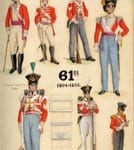Walcheren, Oporto and Talavera
Five months after the evacuation of the army from Corunna back to England in January 1809, the 28th (North Gloucestershire) Regiment were sent abroad again, this time on the ill-fated Walcheren expedition in the Netherlands. The expedition resulted in nothing except for heavy losses in both dead and sick from Walcheren Fever, probably malaria.
The 28th were particularly hard hit after arriving back in their old quarters in Colchester. Lt.Colonel Charles Cadell wrote: “We had hardly settled, when the dreadful fever broke out amongst us. It was truly melancholy to behold the numbers that were cut off: every evening about dusk a string of from eight to ten fine fellows were carried to their graves! The deaths were so numerous that a corporal and eight men only attended each funeral.”
The army had in fact not quit the Iberian Peninsula entirely, for a garrison in Lisbon had been left behind, including 200 men of the 28th in a Battalion of Detachments. When Sir Arthur Wellesley returned to Portugal on 22nd April, he quickly assembled his army, 20,000 strong, including the Battalion of Detachments, and in a lightning advance, bounced the French army under Marshal Soult out of Oporto. Following up his success in ejecting the French from Portugal, and in what was to be an unhappy experience of co-operation with his Spanish ally, General Cuesta, Wellesley advanced deep into central Spain, linking up with the Spanish army at Oropesa near Talavera on the River Tagus, three days march from King Joseph’s Bonaparte’s capital of Madrid. Reinforcements had been hurrying from Lisbon to join the army through a series of forced marches into Spain.
The 61st (South Gloucestershire) Regiment, 1,000 men strong, joined the army at Oropesa on 20th July, and on the night of 27th July the combined armies were attacked in their defensive positions at Talavera. The French attacks were resumed the following day, and Lieutenant Charlton of the 61st’s Grenadier company described the action: “About 10 in the morning we had a fine view of King Joseph surrounded by his body Guards. His Majesty took especial care to keep his Royal person out of the reach of our Artillery. The action was continued with varied success in the woods until about 1 o’clock. It was then obvious from the enemy’s movements that a desperate attempt on our whole line was in contemplation. Our division received orders to charge the enemy with the bayonet the moment their caps could be seen as they ascended the ravine which was about 100 yards in our front. The French line of Infantry advanced supported by Artillery and Cavalry with cries of ‘Vive Napoleon!’.
The 61st, 83rd and Guards, with loud cheers, rushed towards the enemy with the bayonet, repulsing them, but continuing the pursuit too far, were much exposed, in returning to their ground, to the fore of the French Artillery and retreating Columns. These Regiments were also threatened with a charge of cavalry which being observed, the 48th Regiment and a body of Dragoons were brought forward to cover their Reformation.
The enemy bringing up fresh troops, the action was continued with great obstinacy until about 6 o’clock, when their efforts became weaker, and before 7 o’clock the French fell back, completely repulsed at every point. In these several attacks the 61st lost 15 officers and nearly three hundred Non Commissioned Officers and Privates. With heartfelt sorrow I learnt that my ever lamented friend, Major Orpen, was killed in the last charge by a musket shot in the breast.”
Picture: Uniforms of the 61st Foot, 1804-1833. Original watercolour in the Soldiers of Gloucestershire Museum.


